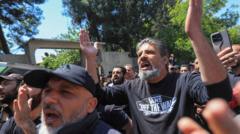In April, a wave of violence erupted in the Druze-majority area of Ashrafiyat Sahnaya, south of Damascus, triggering fear and insecurity within the community. One resident, Lama al-Hassanieh, recounted the terror she experienced as gunfire broke out nearby, leaving her uncertain of who was attacking. Concerns about identity and safety have surged, especially as extremist voices have amplified calls for violence against Druze individuals following a controversial and later debunked recording.
Historically, the Druze have carved out a complex political allegiance under the Assad regime, attempting to navigate sectarian conflicts by aligning with the government—an approach that offered them a degree of safety amidst Syria's civil war. However, with the rise of Sunni Islamist-led opposition forces, that sense of security is rapidly deteriorating. Attacks on Druze communities have intensified, prompting local militia formations for self-defense.
The recent violence has prompted widespread distrust, not only towards extremist factions but also toward the government. Students at Damascus University, including pharmacy student Lama Zahereddine, faced violent harassment simply due to their Druze identity, leaving them questioning their future in a country where they once felt a semblance of safety.
Many Druze, like Hadi Abou Hassoun who was injured while defending his community, express a desire for legal protection rather than religious or sectarian affiliation. As Israel intervened with airstrikes in support of the Druze, the internal divide has become increasingly apparent.
Though the immediate violence has subsided, trust among neighbors and towards the government remains fragile. "We are Syrians," comments al-Hassanieh, noting her community's demand for equal rights and accountability for those who have perpetrated violence against them. The Druze community's fight for recognition and protection in post-war Syria continues amidst uncertainty and fear.



















